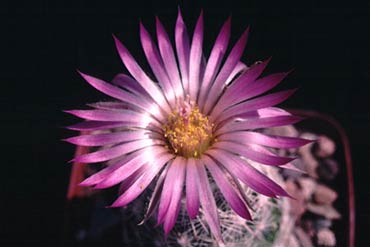Corypantha Vivipara |
|||||||||
A common plant in parts of its range forming clusters or growing as a solitary plant . Often hidden in grasses or under sheltering shrubs or desert trees. A large and beautiful flower makes this otherwise obscure plant stand out in the dull browns of the grasslands of midsummer. |
|||||||||
Plant: A globular to stoutly cylindrical plant growing singularly or in clusters of up to 50 stems. The green tuberculate stem is obscured by spines. Stem 5 to 7cm (2 to 3in) in diameter and up to 10cm tall. Tubercules are 1 to 2cm (0.4 to 0.8in) tall. |
|||||||||
Spines: White spines with reddish to brown tips, 5 to 6 centrals 1 to 1.5cm (0.4 to 0.6in) long mingling with 15 to 30 radials 1 to 1.5cm (0.4 to 0.6in) long. |
|||||||||
Flower: A large showy pink to lavender flower appears in June, 3 to 5cm (1 to 2in) across with slender lancolate petaloids. |
|||||||||
Fruit: Green, with a purple tinge, ellipsoidal 12 to 25mm (0.5 to 1in) long and 10 to 15mm (0.4 to 0.6in) in diameter, sometimes slightly scaled. Seed brown, reticulate, about 1 mm wide and 2mm long somewhat semicircular. |
|||||||||
|
|||||||||
|
|||||||||
| More widely distributed than its close relative the Missouri pincushion cactus, common pincushion occurs across all but northeastern North Dakota. Elsewhere, the plant ranges from Alberta and Manitoba to Texas and New Mexico. Both plants are commonly called "ball cactus". | |||||||||
|

